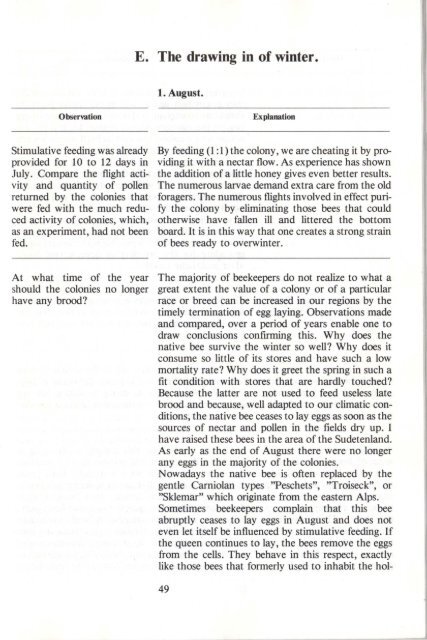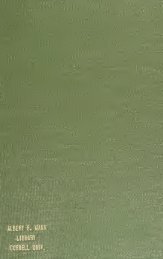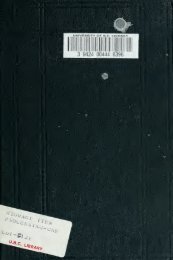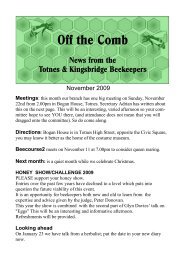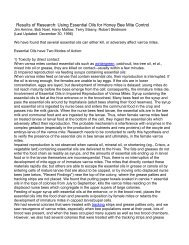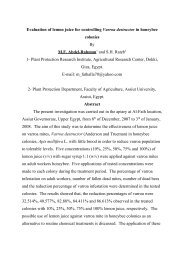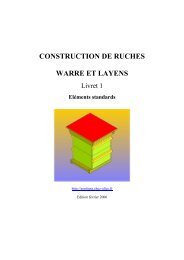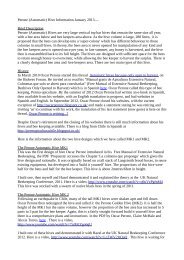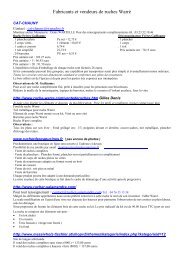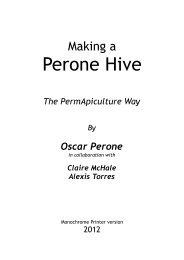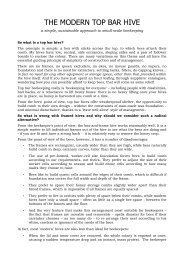You also want an ePaper? Increase the reach of your titles
YUMPU automatically turns print PDFs into web optimized ePapers that Google loves.
E. The drawing in of winter.<br />
1. August.<br />
Observation<br />
Explanation<br />
Stimulative feeding was already By feeding (1 : 1) <strong>the</strong> colony, we are cheating it by proprovided<br />
for 10 to 12 days in viding it with a nectar flow. As experience has shown<br />
July. Compare <strong>the</strong> flight acti- <strong>the</strong> addition of a little honey gives even better results.<br />
vity and quantity of pollen The numerous larvae demand extra care from <strong>the</strong> old<br />
returned by <strong>the</strong> colonies that foragers. The numerous flights involved in effect puriwere<br />
fed with <strong>the</strong> much redu- fy <strong>the</strong> colony by eliminating those bees that could<br />
ced activity of colonies, which, o<strong>the</strong>rwise have fallen ill and littered <strong>the</strong> bottom<br />
as an experiment, had not been board. It is in this way that one creates a strong strain<br />
fed.<br />
of bees ready to overwinter.<br />
<strong>At</strong> what time of <strong>the</strong> year<br />
should <strong>the</strong> colonies no longer<br />
have any brood?<br />
The majority of beekeepers do not realize to what a<br />
great extent <strong>the</strong> value of a colony or of a particular<br />
race or breed can be increased in our regions by <strong>the</strong><br />
timely termination of egg laying. Observations made<br />
and compared, over a period of years enable one to<br />
draw conclusions confirming this. Why does <strong>the</strong><br />
native bee survive <strong>the</strong> winter so well? Why does it<br />
consume so little of its stores and have such a low<br />
mortality rate? Why does it greet <strong>the</strong> spring in such a<br />
fit condition with stores that are hardly touched?<br />
Because <strong>the</strong> latter are not used to feed useless late<br />
brood and because, well adapted to our climatic conditions,<br />
<strong>the</strong> native bee ceases to lay eggs as soon as <strong>the</strong><br />
sources of nectar and pollen in <strong>the</strong> fields dry up. I<br />
have raised <strong>the</strong>se bees in <strong>the</strong> area of <strong>the</strong> Sudetenland.<br />
As early as <strong>the</strong> end of August <strong>the</strong>re were no longer<br />
any eggs in <strong>the</strong> majority of <strong>the</strong> colonies.<br />
Nowadays <strong>the</strong> native bee is often replaced by <strong>the</strong><br />
gentle Carniolan types "Peschets", "Troiseck", or<br />
"Sklemar" which originate from <strong>the</strong> eastern Alps.<br />
Sometimes beekeepers complain that this bee<br />
abruptly ceases to lay eggs in August and does not<br />
even let itself be influenced by stimulative feeding. If<br />
<strong>the</strong> queen continues to lay, <strong>the</strong> bees remove <strong>the</strong> eggs<br />
from <strong>the</strong> cells. They behave in this respect, exactly<br />
like those bees that formerly used to inhabit <strong>the</strong> hol-<br />
49


